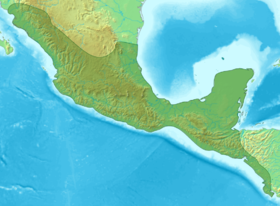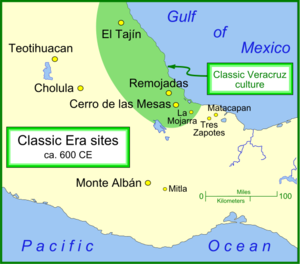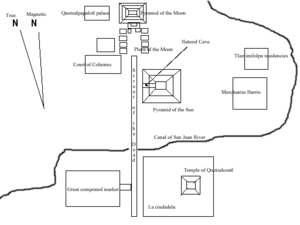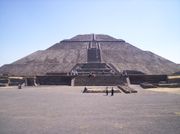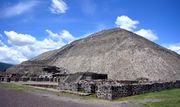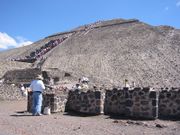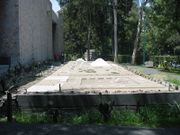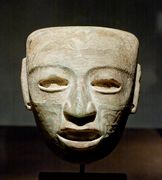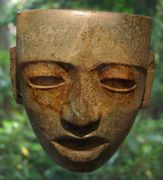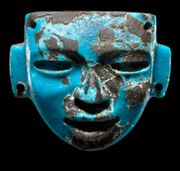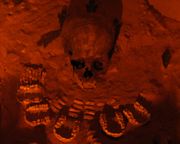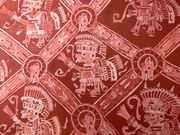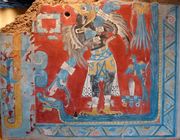تيوتهواكان
19°41′33″N 98°50′37.68″W / 19.69250°N 98.8438000°W
| تيوتهواكان Teotihuacan | |
|---|---|
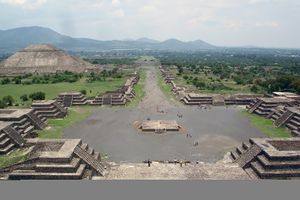 منظر لساحة الأموات وهرم الشمس، من هرم القمر. | |
| الموقع | |
| الأحداثيات | 19°41′33″N 98°50′37.68″W / 19.69250°N 98.8438000°W |
| البلد | |
| البلدية | سان خوان تيوتهواكان |
| التاريخ | |
| الفترة | أواخر العصر قبل الكلاسيكي حتى الكلاسيكي المتأخر |
| Official name: مدينة تيوتهواكان قبل الهيسپانية | |
| النوع | ثقافي |
| المعيار | i, ii, iii, iv, v |
| عُين | 1987 (القسم 11) |
| الرقم المرجعي | 414 |
| الدولة | |
| المنطقة | أمريكا اللاتينية والكاريبي |
تيوتهواكان Teotihuacan /teɪˌoʊtiːwəˈkɑːn/,[1] تُكتب أيضاً Teotihuacán (بالإسپانية teotiwa'kan)، هي مدينة ميزوأمريكية قبل الكولمبية تقع في وادي المكسيك، على بعد 30 كم شمال شرق مكسيكو سيتي المعاصرة، تشتهر اليوم كموقع للكثير من الأهرامات الميزوأمريكية الأثرية الشهيرة التي بنتي في الأمريكتين قبل الكولمبية. بغض النظر عن الأهرام، تحمل تيوتهواكان أهمية أنثروپولوجية بسبب مجمعاتها، المجمعات السكنية متعددة العائلات، ساحة الأموت، وجزء صغير من اللوحات الجدارية المحفوظة جيداً على نحو استثنائي.
. . . . . . . . . . . . . . . . . . . . . . . . . . . . . . . . . . . . . . . . . . . . . . . . . . . . . . . . . . . . . . . . . . . . . . . . . . . . . . . . . . . . . . . . . . . . . . . . . . . . . . . . . . . . . . . . . . . . . . . . . . . . . . . . . . . . . . . . . . . . . . . . . . . . . . . . . . . . . . . . . . . . . . . .
الاسم
التاريخ
الأصول والتأسيس
تقول آخر الاكتشافات أن تاريخ المدينة ربما يبدأ لقرن أو اثنين قبل الميلاد وبدأت مثل رقعة شطرنج في بنايات على ارتفاع 2300 متر فوق مستوى سطح البحر ثم ازدهرت بالقصور والمساكن حتى وصلت لنحو 20 كم2، وأما أكبر أهراماتهم فهو هرم الشمس وحملوا أطنانا من التراب لتكوين هذا الهرم وهو في نفس مساحة هرم خوفو إلا أنه أقصر منه ويبلغ طوله 62 مترا. وتوجد على قمته معبد نجا من أغلب الكوارث، والزعم يرى أن بناءه كان على نقطة في الأفق حيث تغرب الشمس في الانقلاب الصيفي إن كان اسم هرم الشمس مناسباً أكثر. وهناك هرم آخر وهو أقصر بنحو 40 مترا يعرف بهرم القمر ولا يوجد معبد عليه.
وفي القرن الأول للميلاد تم بناء معبد لكيتزالكواتل إله الريح وتلالوك إله المطر وكلها أسماء أزتكية وقد شيدت الأبنية الكلاسيكية ضمن أراضي مرتفعة في غواتيمالا بأسلوب تالود نابليرو وشاع استخدام الآنية الثلاثية القوائم والأغطية المخروطية وقد وصل تأثير تيوتيهواكان إلى أراضي المايا المنخفضة فقد عثر على الفخار في عدد من المواقع في يوكانان وضمن نطاق أراضي المايا الجنوبية وحتى كوبان في هندوراس وكانت السلالة الحاكمة في نيكال على صلة وثيقة مع تيوتيهواكان كما الآثار حيث تبين حاكما مرتديا التاج و الصولجان والشعارات التي تميز المايا إلا أن هناك محاربين ملابس الحرس و لا يعرف بالضبط هوية الحاكم بيد أن هناك احتمالا كبيرا أن يكون من الأتباع الذين نصبهم التيوتيهواكانييون ومنحوه نوعا من الحماية.
الزنيث
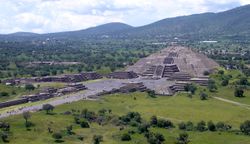
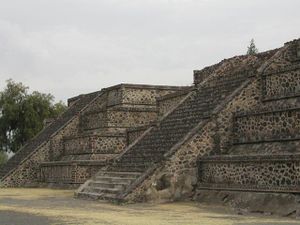
الانهيار
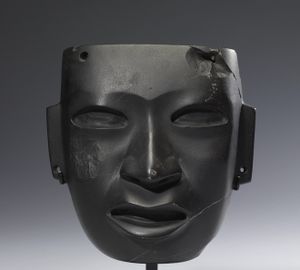
بدأت تيوتيهواكان تنحدر في القرن السادس بشكل متزايد بسبب انتزاع الغابات وحلت محلها السهوب فأتى الجفاف ومعه المجاعة فتركها أهلها وفي عام 750 تقريبا كانت المدينة مهجورة لتأتي ققبائل تولتك لتدق المسمار الأخير في نعش المدينة عام 900 تقريبا عندما هاجموها بقيادة زعيمهم كيتزال كواتل.
الثقافة
العرقية
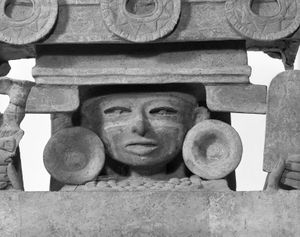
الدين
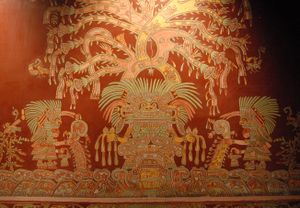
الاقامة
الموقع الأثري
التنقيبات والاكتشافات
يرى علماء الآثار أن هناك أحياء عاش فيها العمال والحرفيون، وفيها وجدوا أدوات وأسلحة صنعت من السبج (زجاج بركاني صلب أسود اللون) وكذلك عُثر على مصنوعات من التراب والذهب للطبقات الأعلى.
أصبحت المدينة مركزا مزدهرا للدين والتجارة في القرنين الأول والثاني وفي وقت ما وصل سكانها إلى 150,000 نسمة وزُينت جدران المعابد والقصور برسوم وصور رائعة لآلهتهم وكذلك أقنعتهم والتي تم نحتها بالصخر أحجار الفيروز والسبج وأصداف بلح البحر الحمراء وعروق اللؤلؤ.
وقد أظهر مشروع نفذته جامعة روجستر لوضع خرائط للمدينة والذي تم فيه فحص أكثر من 5000 بناية وجمع الملتقطات السطحية من كل المنطقة أنه كانت هناك 400 محل عمل لصنع الأدوات والأسلحة و300 مصنع للفخار وعدد من المصانع للحرف الأخرى ووجدوا أيضا أن المدينة كانت مقسمة إلى عدد من المحلات المخصصة لحرف متعددة وكان أحد المحلات ذا أهمية خاصة حيث كان كل الفخار والمصنوعات اليدوية مصنوعة وفق أسلوب أواكساكا وفيه أيضا مقبرة مشيدة بالأسلوب نفسه إلا أن الأبنية كانت مصممة حسب أسلوب تيوتيهواكان ومن غير المؤكد أن تكون هذه المحلات أجزاء منفصلة من المدينة يرتادها التجار الذين يأتون إلى تيوتيهواكان أو محل إقامة سفراء المقاطعات وهناك احتمال في أنها كانت محلات إقامة جبرية للرهائن في تيوتيهواكان الذين كانوا يحتجزون فيه لضمان طاعة الأقاليم التي ينتمون إليها.[2]
. . . . . . . . . . . . . . . . . . . . . . . . . . . . . . . . . . . . . . . . . . . . . . . . . . . . . . . . . . . . . . . . . . . . . . . . . . . . . . . . . . . . . . . . . . . . . . . . . . . . . . . . . . . . . . . . . . . . . . . . . . . . . . . . . . . . . . . . . . . . . . . . . . . . . . . . . . . . . . . . . . . . . . . .
تخطيط الموقع
تهديد من التطوير
معرض الصور
صورة أمامية من هرم الشمس
Model of the Teotihuacan site located at National Museum of Anthropology in Mexico City.
Detail of a collective burial of those slaughtered as part of the rites of consecration for the Pyramid of the Feathered Serpent (phase Miccaotli, c. 200 A.C.) In this case, all buried bodies had their hands tied behind their backs. The necklace is made of pieces that simulate human jaws, but other subjects buried wore necklaces with actual jaws.
Detail of the murals of the palace of Atetelco, dated in Xolalpan phase ( c. 450-650).
After the fall of Teotihuacan, several sites of central Mesoamerica flourished. Some of them, like Cacaxtla, reveal a remarkable Mayan influence, as seen in this reproduction of the murals in the city.
انظر أيضاً
- Balberta, a Teotihuacan trading partner on the Pacific Coast of Guatemala
- Cerro de la Estrella, a large Teotihuacano-styled pyramid in what is now part of Mexico City
- List of archaeoastronomical sites by country
- List of megalithic sites
- List of Mesoamerican pyramids
- Montana (Mesoamerican site), a Teotihuacan colony on the Pacific Coast of Guatemala
- Robert E. Lee Chadwick, an American anthropologist and archeologist
- Spring equinox in Teotihuacán
المصادر
الهوامش
- ^ "Teotihuacán". Oxford Dictionaries. Oxford University Press. Retrieved 30 May 2013.
- ^ كتاب موسوعة الآثار التاريخية/حسين حماد، عمان: دار أسامة للنشر، 2003، ص 220
المراجع
- Berrin, Kathleen (1993). Teotihuacan: Art from the City of the Gods. New York: Thames and Hudson. ISBN 0-500-23653-4. OCLC 28423003.
{{cite book}}: Unknown parameter|coauthors=ignored (|author=suggested) (help)CS1 maint: multiple names: authors list (link) - Braswell, Geoffrey E. (2003). "Introduction: Reinterpreting Early Classic Interaction". In Geoffrey E. Braswell (ed.). The Maya and Teotihuacan: Reinterpreting Early Classic Interaction. Austin: University of Texas Press. pp. 1–44. ISBN 0-292-70587-5. OCLC 49936017.
{{cite book}}: CS1 maint: multiple names: authors list (link) - Brown, Dale M. (ed.) (1992). Aztecs: Reign of Blood and Splendor. Lost Civilizations series. Alexandria, VA: Time-Life Books. ISBN 0-8094-9854-5. OCLC 24848419.
{{cite book}}:|author=has generic name (help)CS1 maint: multiple names: authors list (link) - Cheek, Charles D. (1977). "Excavations at the Palangana and the Acropolis, Kaminaljuyu". In William T. Sanders and Joseph W. Michels (ed.). Teotihuacan and Kaminaljuyu: a Study in Prehistoric Culture Contact. University Park: Pennsylvania State University Press. pp. 1–204. ISBN 0-271-00529-7. OCLC 3327234.
{{cite book}}: CS1 maint: multiple names: authors list (link) - Coe, Michael D. (1994) [1962]. Mexico: From the Olmecs to the Aztecs. New York: Thames & Hudson. ISBN 0-500-27722-2. OCLC 50131575.
{{cite book}}: Unknown parameter|coauthors=ignored (|author=suggested) (help)CS1 maint: multiple names: authors list (link) - Coe, Michael D. (1986). Atlas of Ancient America. New York: Facts on File. ISBN 0-8160-1199-0.
{{cite book}}: Unknown parameter|coauthors=ignored (|author=suggested) (help)CS1 maint: multiple names: authors list (link) - Cowgill, George L. (1992). "Teotihuacan Glyphs and Imagery in the Light of Some Early Colonial Texts". In Janet Catherine Berlo (ed.). Art, Ideology, and the City of Teotihuacan: A Symposium at Dumbarton Oaks, 8th and 9th October 1988. Washington, DC: Dumbarton Oaks Research Library and Collection. pp. 231–46. ISBN 0-88402-205-6. OCLC 25547129.
{{cite book}}: CS1 maint: multiple names: authors list (link) - Cowgill, George (1997). "State and Society at Teotihuacan, Mexico" (PDF online reproduction). Annual Review of Anthropology. Palo Alto, CA: Annual Reviews Inc. 26 (1): 129–161. doi:10.1146/annurev.anthro.26.1.129. OCLC 202300854.
{{cite journal}}: CS1 maint: multiple names: authors list (link) - Davies, Nigel (1982). The Ancient Kingdoms of Mexico. England: Penguin Books. ISBN 0-14-013587-1.
{{cite book}}: CS1 maint: multiple names: authors list (link) - Heyden, Doris (1975). "An Interpretation of the Cave underneath the Pyramid of the Sun in Teotihuacan, Mexico". American Antiquity. Menasha, WI: Society for American Archaeology. 40 (2): 131–147. doi:10.2307/279609. JSTOR 279609. OCLC 1479302.
{{cite journal}}: Cite has empty unknown parameter:|coauthors=(help)CS1 maint: multiple names: authors list (link) - Kaufman, Terrence (2001). "Nawa linguistic prehistory". Mesoamerican Language Documentation Project.
{{cite web}}: CS1 maint: multiple names: authors list (link) - Laporte, Juan Pedro (2003). "Architectural Aspects of Interaction Between Tikal and Teotihuacan during the Early Classic Period". In Geoffrey E. Braswell (Ed.) (ed.). The Maya and Teotihuacan: Reinterpreting Early Classic Interaction. Austin: University of Texas Press. pp. 199–216. ISBN 0-292-70587-5. OCLC 49936017.
{{cite book}}: CS1 maint: multiple names: authors list (link) - Malmström, Vincent H. (1978). "Architecture, Astronomy, and Calendrics in Pre-Columbian Mesoamerica" (PDF Reprinted). Journal for the History of Astronomy. 9: 105–116. Retrieved 2007-01-17.
{{cite journal}}: CS1 maint: multiple names: authors list (link) - Miller, Mary (1993). The Gods and Symbols of Ancient Mexico and the Maya: An Illustrated Dictionary of Mesoamerican Religion. London: Thames & Hudson. ISBN 0-500-05068-6. OCLC 27667317.
{{cite book}}: Unknown parameter|coauthors=ignored (|author=suggested) (help)CS1 maint: multiple names: authors list (link) - Millon, René (1993). "The Place Where Time Began: An Archaeologist's Interpretation of What Happened in Teotihuacan History". In Berrin, Kathleen and Esther Pasztory (Eds.) (ed.). Teotihuacan: Art from the City of the Gods. New York: Thames and Hudson. pp. 16–43. ISBN 0-500-23653-4. OCLC 28423003.
{{cite book}}: CS1 maint: multiple names: authors list (link) - Pasztory, Esther (1992). "Abstraction and the rise of a utopian state at Teotihuacan", in Janet Berlo, ed. Art, Ideology, and the City of Teotihuacan, Dumbarton Oaks, pp. 281-320.
- Schele, Linda (1998). The Code of Kings: The Language of Seven Sacred Maya Temples and Tombs. New York: Scribner. ISBN 0-684-80106-X. OCLC 37819972.
{{cite book}}: Unknown parameter|coauthors=ignored (|author=suggested) (help)CS1 maint: multiple names: authors list (link) - Sugiyama, Saburo (2003). Governance and Polity at Classic Teotihuacan; in Julia Ann Hendon, Rosemary A. Joyce, "Mesoamerican archaeology". Wiley-Blackwell.
{{cite book}}: CS1 maint: multiple names: authors list (link) - Séjourné, Laurette,Un Palacio en la ciudad de los dioses, Teotihuacán, Mexico, Instituto nacional de antropología e historia, 1959.
- Séjourné, Laurette (1962) El Universo de Quetzalcóatl, Fondo de Cultura Económica.
- Séjourné, Laurette (1966) Arqueología de Teotihuacán, la cerámica, Fondo de Cultura Económica.
- Séjourné, Laurette (1969) Teotihuacan, métropole de l'Amérique, Paris, F. Maspero.
- Šprajc, Ivan; Sprajc, Ivan (2000). "Astronomical Alignments at Teotihuacan, Mexico". Latin American Antiquity. Washington, DC: Society for American Archaeology. 11 (4): 403–415. doi:10.2307/972004. JSTOR 972004.
{{cite journal}}: CS1 maint: multiple names: authors list (link) - Taube, Karl A. (2000). The Writing System of Ancient Teotihuacan (PDF). Ancient America series. Vol. 1. Barnardsville, NC: Center for Ancient American Studies. OCLC 44992821.
{{cite book}}: CS1 maint: multiple names: authors list (link) - Varela Torrecilla, Carmen (2003). "Teotihuacan and Oxkintok: New Perspectives from Yucatán". In Geoffrey E. Braswell (ed.). The Maya and Teotihuacan: Reinterpreting Early Classic Interaction. Austin: University of Texas Press. pp. 249–72. ISBN 0-292-70587-5. OCLC 49936017.
{{cite book}}: Unknown parameter|coauthors=ignored (|author=suggested) (help)CS1 maint: multiple names: authors list (link) - Weaver, Muriel Porter (1993). The Aztecs, Maya, and Their Predecessors: Archaeology of Mesoamerica (3rd ed.). San Diego: Academic Press. ISBN 0-01-263999-0.
{{cite book}}: CS1 maint: multiple names: authors list (link) - Webmoor, Timothy (2007). "Reconfiguring the Archaeological Sensibility: Mediating Heritage at Teotihuacan, Mexico" (online digital publication). Symmetrical Archaeology [2005–, collaboratory directors T. Webmoor and C. Witmore]. PhD thesis. Stanford Archaeology Center/Metamedia Lab, Stanford University. Retrieved 2008-06-02.
{{cite journal}}: CS1 maint: multiple names: authors list (link)
. . . . . . . . . . . . . . . . . . . . . . . . . . . . . . . . . . . . . . . . . . . . . . . . . . . . . . . . . . . . . . . . . . . . . . . . . . . . . . . . . . . . . . . . . . . . . . . . . . . . . . . . . . . . . . . . . . . . . . . . . . . . . . . . . . . . . . . . . . . . . . . . . . . . . . . . . . . . . . . . . . . . . . . .
وصلات خارجية
- Teotihuacan Research Guide, academic resources and links, maintained by Temple University
- Teotihuacan article by Encyclopædia Britannica
- Teotihuacan Photo Gallery, by James Q. Jacobs
- Mesoamerican Photo Archives: Teotihuacan, by David Hixson
- 360° Panoramic View of the Avenue of the Dead, the Pyramid of the Sun and the Pyramid of the Moon , by Roland Kuczora
- Pages using gadget WikiMiniAtlas
- صفحات بالمعرفة فيها قوالب حماية خطأ
- Coordinates on Wikidata
- مقالات تتضمن نطق مسجل
- CS1 errors: unsupported parameter
- CS1 errors: generic name
- مواقع التراث العالمي في المكسيك
- تيوتهواكان
- شعوب قديمة
- مواقع ميزوأمريكية
- متاحف تاريخية في المكسيك
- منطقة مكسيكو سيتي الكبرى
- Archaeoastronomy
- مواقع قديمة
- أماكن مأهولة سابقة في المكسيك
- مواقع أثرية في ولاية مكسيكو
- متاحف في ولاية مكسيكو
- متاحف أثرية في المكسيك
